View Larger Image
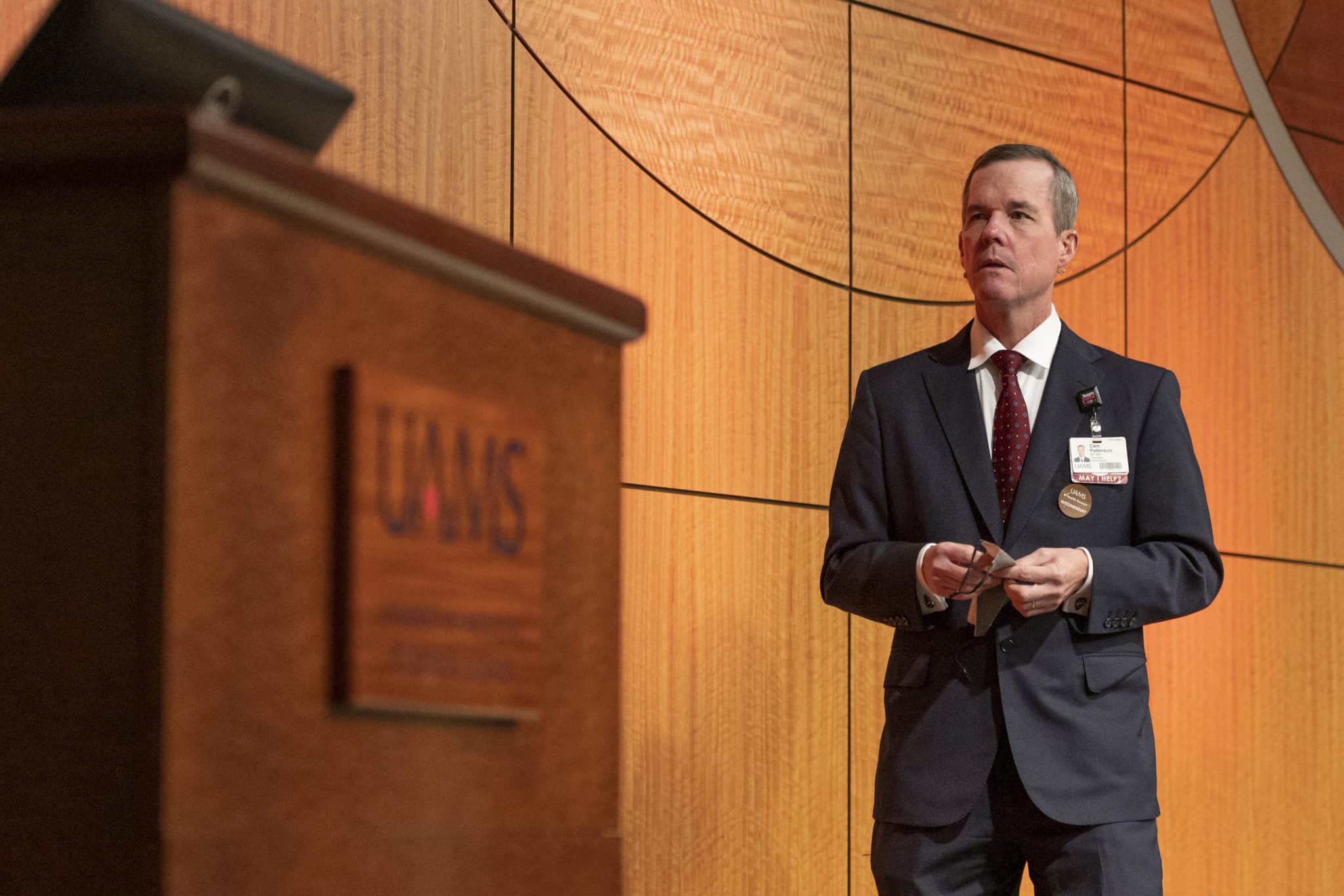
Chancellor Cam Patterson, M.D., MBA, urged Team UAMS members to forgo traveling and large gatherings this holiday season.
Image by Evan Lewis
COVID-19 Response Takes Center Stage at Town Hall
| The COVID-19 pandemic and the state’s rising numbers took center stage Dec. 2 during the chancellor’s monthly Town Hall.
Chancellor Cam Patterson, M.D., MBA, and UAMS Health CEO, urged employees to continue to be role models at work and in the community by wearing masks, practicing social distancing and washing hands frequently.
“I also urge you to take one other step. I know the holidays are a time for gathering with loved ones. Unfortunately, large gatherings and travel increase your chances of getting and spreading COVID-19,” he said. “Our senior leadership team has pledged not to travel over the holidays and to stay home. I hope you too will take that pledge.”
UAMS partnered with the Arkansas Department of Health and the governor’s office to create a marketing campaign to raise awareness about the power everyone has to fight COVID-19. Barbara McDonald, a nurse practitioner at UAMS, stars in the campaign’s first video spot.
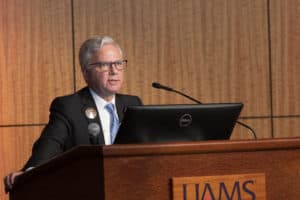
Steppe Mette, M.D., CEO of the Medical Center, updates employees on UAMS’ response to the COVID-19 pandemic.Evan Lewis
Steppe Mette, M.D., senior vice chancellor of UAMS Health and CEO of the Medical Center, gave an update on COVID-19 at UAMS.
“For the past nine months, UAMS has risen to the occasion by being able to treat every patient who has come to us for help,” said Mette. “We have cared for and discharged more than 800 patients with COVID-19. Thank you to all of the front-line workers who have been instrumental in this fight.”
As of Dec. 2, Arkansas had more than 16,000 active cases of COVID-19, with 1,088 in the hospital and 186 on ventilators. UAMS had 54 confirmed COVID patients, 17 of whom were in the ICU.
“The overall capacity to care for patients is being challenged across the state,” Mette warned, adding that UAMS is in “pretty good shape.”
UAMS recently opened up 12 new ICU beds on F4 and reopened H9 and F9 as COVID units as part of the surge plan, he said. UAMS has added additional adult ventilators, giving us approximately 100.
“We’ve done a lot, and we have the capacity to take on more patients,” Mette said. “My biggest concern is our most precious resource – all of you. I remain confident we are a resilient bunch, and we will persevere.”
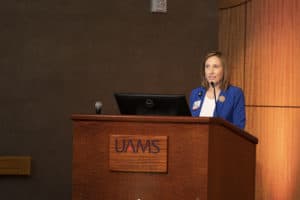
Chief Financial Officer Amanda George, MHSA, CPA, reports that UAMS continues to beat budget estimates for fiscal year 2021.Evan Lewis
Patterson also thanked the nurses, physicians, technicians, cleaning and transportation staff who are on the front lines of the battle against COVID.
Christina Clark, MBA, vice chancellor for institutional support services and chief operating officer, shared a video on the revised dress code, which merges the Administrative and Clinical dress codes into a single policy. The combined policy takes effect Jan. 1, 2021.
The new policy would allow non-clinical employees to wear jeans with a UAMS T-shirt and their supervisor’s approval. UAMS T-shirts can be worn daily, including with scrubs. Facial hair should be neatly trimmed and no longer than an inch long.
Clark noted that employees may request exceptions to the dress code policy for medical and religious or cultural reasons. More information on the policy is available in the UAMS Announcements.
Clark also gave an update on the ongoing energy project and the rerouting of Pine and Cedar streets.
UAMS received the first generator for the new energy plant on Nov. 30, and the rest are expected by the end of December, Clark said. Another part of the energy project is installing LED lights in all buildings and parking decks on campus. That project is 70% completed, she said, noting that the upgrades in the Medical Center have been delayed because our elevated patient census.
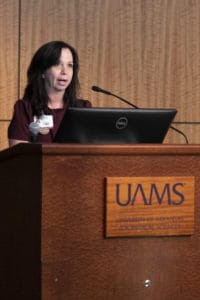
Chief Operating Officer Christina Clark, MBA, discusses changes to the employee dress code.Evan Lewis
The Neighborhood Fitness Court, which was supported by a National Fitness Campaign grant, has been completed and is open to employees and students, she said. Once construction of the energy plant is completed, the court will be opened to the public.
Finally, the work on Pine and Cedar has begun with some lane closures and traffic rerouting. She urged employees not to drive through the Walgreens and Subway parking lots to bypass the Plateau Street closure.
Amanda George, MHSA, CPA, vice chancellor for finance and chief financial officer, offered an update on UAMS finances. UAMS continues to beat budget estimates, which were set very conservatively because of the pandemic, she said. Officials budgeted a $32.8 million deficit for this point in the 2021 fiscal year, but instead, UAMS is running a $15.6 million surplus. If federal CARES funding was subtracted, UAMS would be $3 million down, she said.
In key clinical volume indicators, UAMS is ahead of estimates in total inpatient discharges, Emergency Department visits and total surgical cases, she said. UAMS also has completed more than 32,000 COVID screening visits this fiscal year.
Finally, Dean Mark Williams, Ph.D., of the College of Public Health, presented the college’s latest COVID-19 forecasts, which he warned contained “some daunting statistics.”
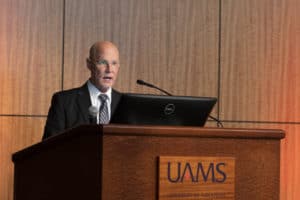
Mark Williams, Ph.D., dean of the College of Public Health, discusses the college’s latest COVID-19 forecasts, which include “some daunting statistics.”Evan Lewis
The short-term model forecasts a cumulative 180,542 COVID-19 cases by Dec. 14 – an increase of more than 24,000 over the state’s numbers on Nov. 29.
“In the next two weeks, we will equal the number of reported COVID-19 cases as were recorded by the state between March 11 and July 4,” he said.
The 15-day forecast for cumulative hospitalizations is 9,756 by Dec. 14 – an increase of 913 over the number on Nov. 29.
Finally, the 15-day model for fatalities predicts 2,709 cumulative deaths due to COVID-19 disease by Dec. 14 – an increase of 239 deaths over the number reported on Nov. 29.
“At the beginning of the pandemic in Arkansas, it took four months to experience the number of deaths from COVID-19 as we will have in the next two weeks,” Williams said.
“Our conclusion is that COVID-19 has entered a period of community spread,” he said. “What this means, using a forest fire as an analogy, the fire in Arkansas was basically smoldering. Since mid-November, the fire has built up enough energy to begin burning through the forest. It will continue burning out of control, increasing in speed until there is no fuel left, or something comes along to put it out.”
“The good news is fire department is on the way, in the form of a vaccine. The bad news is they will not arrive until the end of March or the beginning of Aril, at the earliest,” he said. “Until then, we are entering a bleak time, a time that will test our health system in the state, and a time when we need to be diligent. What matters now is what each one of us do until the fire department arrives.”
The presentations were followed by a brief question and answer session.